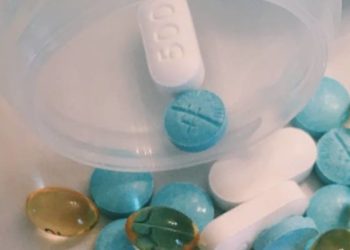2 Minute Medicine Rewind June 24, 2019
Strategies to amend clinician prescription patterns are of critical importance in addressing opioid abuse and opioid-related deaths across the United States. One potential approach involves targeting opioid-prescription practices in the perioperative period. However, little is known about the outcomes of patients who are prescribed opioids and other high-risk medications such as benzodiazepines in the perioperative period. In this retrospective cohort study, 42,170 non-cardiac surgical cases were studied to evaluate the impact of opioid and benzodiazepine prescriptions filled within 6 months preoperatively on short- and long-term survival. Of these cases, 17.7% had prescriptions for opioids only, 7.4% had prescriptions for benzodiazepines only, and 6.2% had prescriptions for both medications. At baseline, patients who received preoperative prescriptions for either opioids, benzodiazepines, or both had a higher incidence of comorbidities and were more likely to have an intermediate or high frailty score. Researchers found that both 30-day and 1-year mortality rates were greater in those who received preoperative prescriptions for both opioids and benzodiazepines compared with other groups (30-day mortality for opioids and benzodiazepines 3.3%, opioids only 1.2%, benzodiazepines only 1.8%, neither medication 1.4%, p<0.001 between all groups; 1-year mortality for opioids and benzodiazepines 11.1%, opioids only 5.6%, benzodiazepines 8.5%, neither medication 4.8%, p<0.001 between all groups). When compared with propensity-matched controls that received no preoperative medications, however, there was no difference in 30-day or long-term mortality for those with a preoperative prescription for opioids only (30-day: 1.3% vs, 1.0%, p=0.23; long-term: HR 1.12, 95% CI 1.01 to 1.24, p=0.03). Similarly, there was no significant difference in 30-day or long-term mortality when assessing benzodiazepines only (30-day: 1.9% vs 1.5%, p=0.32; long-term: HR 1.11, 95% CI 0.98 to 1.26, p=0.11). Finally, researchers found that those who filled opioid or benzodiazepine prescriptions preoperatively were more likely to consume these medications postoperatively (opioids only 43%, benzodiazepines only 23%, both 66%) compared with patients who filled neither prescription (12%) (p<0.001 for all). In summary, this study suggests that preoperative opioid and benzodiazepine prescription fills within 6 months of surgery may be associated with increased short- and long-term mortality, as well as persistent postoperative opioid consumption. This underlines the importance of developing interventions to limit the potential harm of these medications in perioperative settings.
Tenosynovial giant cell tumor (TGCT) is a rare mesenchymal neoplasm that arises in the joints, bursae, or tendon sheaths. The standard treatment is surgical resection, but recurrence is common. Repeated surgery in these patients also carries a risk of increasing morbidity and mortality. Unfortunately, no systemic therapies currently exist. Pexidartinib is a novel small molecule tyrosine-kinase inhibitor which has shown clinical efficacy against recurrent or inoperable TGCT in a phase 1 study. In part one of this randomized controlled trial, 120 patients with advanced TGCT for whom surgery was not recommended were assigned to receive pexidartinib therapy or placebo to study the impact on overall disease response (complete or partial response) at week 25 based on MRI. In part two of the study, all patients received pexidartinib. Due to the emergence of mixed or cholestatic hepatotoxicity, the data monitoring committee stopped enrollment six patients short of the target study population of 126. Researchers found that more patients in the pexidartinib group achieved overall disease response at week 25 than in the placebo group (39% vs. 0%, difference 39%, 95% CI 27% to 53%, p<0.0001). At 6 months, no patient who responded to pexidartinib at week 25 had progressed. Serious adverse events occurred in 13% of patients in the pexidartinib group and in 2% of patients in the placebo group. These cases included three patients in the pexidartinib group who experienced mixed or cholestatic hepatotoxicity, two of which recovered, while the other case lasted 7 months and was confirmed by liver biopsy. Hair color changes (67%), fatigue (54%), and aspartate aminotransferase increase (39%) were the most frequent pexidartinib-associated adverse events. This study was limited by early termination of patient enrollment. Overall, this study suggests that pexidartinib therapy may have significant clinical efficacy in the treatment of advanced TGCT. However, the potential therapeutic benefits of pexidartinib should be weighed against the risk of mixed and cholestatic hepatotoxicity.
In patients who have previously undergone coronary artery bypass graft surgery (CABG), surgical aortic valve replacement (SAVR) can be a complicated procedure due to the risks of sternal re-entry and cardiac or graft injury. Transcatheter aortic valve replacement (TAVR) offers a less invasive approach that may be more optimal in this patient population. The Surgical Replacement and Transcatheter Aortic Valve Implantation (SURTAVI) trial assigned 1,746 patients with severe, symptomatic aortic stenosis to either SAVR or TAVR and found that TAVR was noninferior to surgery in the primary endpoint of a composite of death from any cause or disabling stroke at 2 years. In this secondary post-hoc analysis of the SURTAVI randomized controlled trial, 273 patients who had undergone prior CABG surgery, including 136 who underwent TAVR and 137 who underwent SAVR, were studied to compare the primary outcome of all-cause mortality or disabling stroke at 1-year follow-up. At baseline, 81.6% of patients in the TAVR cohort and 85.4% of patients in the SAVR cohort were male. Researchers found that there was no difference in the primary outcome between the two groups at 1-year follow up (p=0.53). Patients in the TAVR group did, however, report a better quality of life at 30 days (as measured by the mean Kansas City Cardiomyopathy Questionnaire summary score) than those in the SAVR group (p<0.001). Moreover, patients in the TAVR group had better exercise capacity at 1 year (as determined by the 6-minute walk test) than those in the SAVR group (p=0.04). In summary, this study suggests that both SAVR and TAVR are safe in patients with prior CABG surgery, and that TAVR leads to a more rapid improvement in quality of life and exercise tolerance in these patients, supporting its use in this patient group.
Current international guidelines recommend a combination of perioperative chemotherapy and surgery in the treatment of operable gastroesophageal cancer. However, given high mortality rates in patients treated with contemporary perioperative chemotherapy, more clinically efficacious and less toxic regimens are needed. One potential strategy involves combining anti-HER2 agents, such as lapatinib, with neoadjuvant chemotherapy. In this randomized controlled open-label trial, 46 patients with HER2-positive operable gastroesophageal adenocarcinoma were assigned to receive either standard epirubicin, cisplatin, and capecitabine (sECX) or modified ECX plus lapatinib (mECX+L) to determine the safety of adding lapatinib to ECX chemotherapy and to establish a recommended treatment dose for a phase 3 trial. The primary outcome was the proportion of patients experiencing grade 3 or 4 diarrhea with mECX+L. Researchers found that the primary outcome occurred in more patients in the mECX+L group than in the sECX group (21% vs. 0%, respectively). In addition, more patients in the mECX+L arm stopped preoperative treatment early compared to patients in the sECX arm (15% vs. 4%, respectively). The most common preoperative toxic effect in both groups was neutropenia, and toxic effects more common in the mECX+L group included grade 1 or 2 stomatitis and vomiting. Postoperative complication rates were similar in each group, and the rate of toxic effects in the postoperative setting was similar to that in the preoperative setting. This study was limited by its small sample size. Importantly, the FLOT (fluorouracil, oxaliplatin, leucovorin, and docetaxel) regimen was adopted as the new perioperative standard of care in place of ECX after recruitment for this study had been completed, limiting the external validity of the study. Overall, this study suggests lapatinib in addition to ECX may be feasible for the treatment of HER2-positive gastroesophageal adenocarcinoma, although better regimens with less toxic effects, such as FLOT, are being investigated in combination with non-cardiotoxic agents in ongoing trials.
Treatment Outcomes of Immune-Related Cutaneous Adverse Events
Immune-checkpoint inhibitors (ICIs) have significantly improved outcomes in a variety of malignancies. Immune-related adverse events, however, are common and may lead to treatment discontinuation and adverse events. Immune-related cutaneous adverse events (ircAEs) are the most frequent and earliest to develop, but there is no evidence-based consensus regarding the management of these events. In this retrospective analysis, 285 patients with 427 ircAEs related to ICIs were studied to assess the efficacy of topical and systemic treatments prescribed by dermatologists. The most common ircAEs were pruritus (32%) and maculopapular rash (28%). Researchers found that ircAE phenotype was not associated with primary cancer diagnosis, but was associated with ICI class (p=0.007), in that maculopapular rash was predominant in patients who received combination therapy. Furthermore, dermatologic interventions such as topical corticosteroids, oral anti-pruritics, and systemic immunomodulators significantly reduced the severity of ircAEs (mean Common Terminology Criteria for Adverse Events grade 1.74 at diagnosis vs. 0.71 at follow-up, p=0.001). The largest improvement was observed in maculopapular rashes (mean grade reduction -1.40). Treatment patterns did not differ significantly between dermatologists (p=0.06). In all seven patients with corticosteroid-refractory ircAEs, targeted biologic immunomodulatory therapies improved symptoms. Several biomarkers were elevated in patients with ircAEs: serum interleukin-6 (IL-6) was elevated in 52% of patients, and mean immunoglobulin E serum levels were greater in higher-grade ircAEs. Additionally, grade 3 or higher ircAEs were associated with increased absolute eosinophils (OR 4.1, 95% CI 1.3 to 13.4) and IL-10 (OR 23.8, 95% CI 2.1 to 262.5). In summary, this study demonstrates that most patients with ircAEs were treated effectively with dermatologic interventions, and provides a basis for further controlled trials aimed at validating the safety and efficacy of these treatments in ircAEs and other immune-related adverse events. Finally, this study identified eosinophils, IL-6, IL-10, and immunoglobulin E as potential actionable therapeutic targets for immune-related skin toxicities.
Image: PD
©2019 2 Minute Medicine, Inc. All rights reserved. No works may be reproduced without expressed written consent from 2 Minute Medicine, Inc. Inquire about licensing here. No article should be construed as medical advice and is not intended as such by the authors or by 2 Minute Medicine, Inc.







